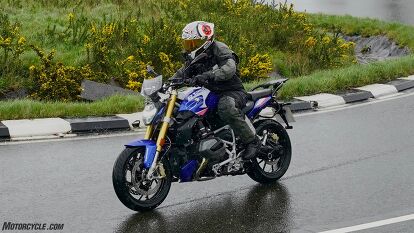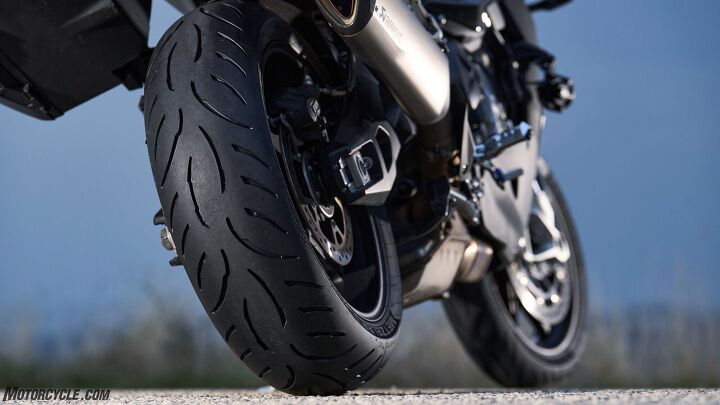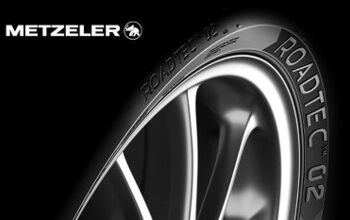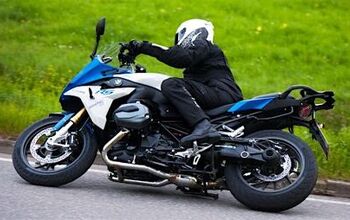Metzeler Roadtec 02 Tire Review

Evaluating a sport-touring tire in extreme conditions
Designing a sport-touring tire must be one of the hardest challenges in motorcycling. In a way, you’re asking for it all. The sport-touring customer wants a tire that offers handling like a sportbike, but with the mileage of a touring bike. And let’s not forget, wet performance is of the utmost importance. Is it possible to have your cake and eat it, too?
Well, the short answer is no. There’s always going to be a compromise somewhere, but that’s not going to stop manufacturers from trying. Naturally, tire companies do their best to examine their current offerings and improve upon them, and when testers like Yours Truly get a hold of these new tires, inevitably the day that we have to see if they’re any good is usually bright and sunny (aka perfect). Not a lot gets learned other than how quickly (or not) a tire comes up to working temperature.
That’s all about to change this time around. If you’ve been dying to know how a sport-touring tire performs in the wet, then you’re in luck, because with the Metzeler Roadtec 02, the company’s latest sport-touring rubber, we were treated to all that the heavens had in store for us. Dark clouds hung above us and pissed down rain like we were cartoon characters destined to bad luck. Not only was it wet, but we were also met with wind blasts, temps in the 40s and 50s, and occasional fog so thick we couldn’t see more than 25 feet in front of us. This is bad weather wherever you are, but for this test we found ourselves at none other than the Isle of Man TT course. Talk about a place where you want confidence in your tires.
Despite all the challenges we faced, I’m happy to report the Roadtec 02s were not one of them.
Tire Tech Talk
More than just round, black, and sticky, there’s some actual science that goes into the making of any tire. I’ll try to keep the boring stuff to a minimum here, but with the Roadtec 02, Metzeler’s goal was to take the Roadtec 01 and improve upon its wet handling, but more importantly, what Metzeler calls “soft” and “hard” handling. In the simplest terms, we’re talking about slow-speed handling (soft) and high-speed handling (hard).
Metzeler’s idea for achieving this was to use the broader profile and stiffer carcass of a sport-touring tire and give it sport compounds. Unlike true sport tires though, sport-touring tires need to be able to work in all kinds of conditions, especially cold and wet ones. This is why the front tire features a new full-silica compound, as silica is excellent at allowing rubber to grip the asphalt, even when temps are low and the ground is wet. In fact, with this new formula, Metzeler says the Roadtec 02 offers 5% more wet grip than the Roadtec 01 and over 10% more grip in the dry. This same silica compound is used on the shoulders of the rear tire for optimum grip while cornering. In the middle, there’s a higher concentration of silica, but it’s not the same level as the front or sides. The harder center compound, combined with Metzeler’s 0º Belt technology, which wraps the steel cords around the circumference of the tire parallel to the direction of travel (instead of perpendicular), not only allows the rear tire to maintain its structure and shape at high speeds, but also helps with longevity and consistent performance as the tire wears.
But the real talking point with the Roadtec 02 is the tread pattern itself. Metzeler’s newest tech, the adaptive Dynatread Technology. Simply put, at low speeds (or Soft handling in Metzeler terms), the tread sipes flex and deform – this is what really gets your tires warm and up to temperature (not weaving). Secondly, it allows water to evacuate. At higher speeds (aka Hard handling), the sipes flex and deform so much that they actually come together and touch, minimizing the void of rubber caused by the sipe in the first place and effectively putting more rubber on the ground.
Of course, Metzeler provided us with diagrams and charts to show us the improvements the Roadtec 02 has over the 01, but the one I found most interesting – and one I hadn’t considered – is how tire design affects the rider aids on today’s motorcycles. Specifically, in this case, ABS. If you can get on the brakes without triggering ABS, then the mechanical grip of the tires can handle the load being put on them, which will bring you to a stop faster. Compared to the Roadtec 01, the 02 triggered ABS less often, and required fewer ABS cycles. The result is the ability to brake later, stop sooner, and experience less of the dreaded ABS pulsing at the lever when it does happen.
Back To The Isle
Certainly the ability to stop is important, especially in the wet, but during our time on the Isle we were more concerned about staying warm, staying dry, and at points simply seeing the road in front of us. Fortunately, we were being led by people who knew the roads better than anyone – primarily Richard “Milky” Quayle. Born and bred on the island, the Manxman is the last local to win a TT race and now guides newcomers to the TT. The fog was so thick in spots I couldn’t see his hi-viz yellow jacket two bikes in front of me. I had to rely on his brake light to know when to slow down.
It’s hard to evaluate tires when the conditions were so treacherous, but as I look back on the ride itself and all the things I had to worry about, the tires weren’t one of them. The BMW R 1250 R I was riding for the majority of the day simply tracked wherever I pointed it. Knee-down lean angles were the last thing on my mind on this day, but when we had the chance to goose it down the Sulby Straight – where the Superbikes touch 200 mph – I got it up to 70 mph without a hint of aquaplaning. Not hero speeds by any means, but it sure was lively considering the conditions. Slowing down didn’t present any drama either. I was never hard on the brakes, but a firm squeeze felt like the tire was digging in and scrubbing speed.
Ultimately, while we all would have much rather ridden the epic course in the dry, these terrible conditions brought out a side of sport-touring rubber we don’t normally get to see – and the Roadtec 02 was impressive. The fastest average speed around the TT course is a tick over 136 mph. I can now say I’ve done the course at an average of 36 mph (probably) in some gnarly conditions and lived to tell the tale. Did Metzeler deliver with its wet performance? I’d say so. Unfortunately, I’ll have to save my thoughts on dry performance for another time. The Roadtec 02 is available in all popular sizes for 17-inch wheels.
In Gear

- Helmet: Shoei X-15 Marquez Motegi 4 Helmet
- Suit: Aerostich R-3 Men’s One-Piece
- Airbag: Alpinestars Tech-Air 5
- Gloves: Racer Gloves Formula - Discontinued
- Boots: RST S-1 Waterproof Boot
Front Tire Sizes
- 120/70 ZR17 M/C (58W) TL
- 110/80 R 19 M/C 59V TL
- 120/70 ZR19 M/C 60W TL
Rear Tire Sizes
- 150/70 R 17 M/C 69V TL
- 160/60 ZR 17 M/C (69W) TL
- 170/60 ZR 17 M/C 72W TL
- 180/55 ZR 17 M/C (73W) TL
- 190/50 ZR 17 M/C (73W) TL
- 190/55 ZR 17 M/C (75W) TL
- 190/55 ZR 17 M/C (75W) TL (O) (for big sport-tourers)
We are committed to finding, researching, and recommending the best products. We earn commissions from purchases you make using the retail links in our product reviews. Learn more about how this works.
Become a Motorcycle.com insider. Get the latest motorcycle news first by subscribing to our newsletter here.

Troy's been riding motorcycles and writing about them since 2006, getting his start at Rider Magazine. From there, he moved to Sport Rider Magazine before finally landing at Motorcycle.com in 2011. A lifelong gearhead who didn't fully immerse himself in motorcycles until his teenage years, Troy's interests have always been in technology, performance, and going fast. Naturally, racing was the perfect avenue to combine all three. Troy has been racing nearly as long as he's been riding and has competed at the AMA national level. He's also won multiple club races throughout the country, culminating in a Utah Sport Bike Association championship in 2011. He has been invited as a guest instructor for the Yamaha Champions Riding School, and when he's not out riding, he's either wrenching on bikes or watching MotoGP.
More by Troy Siahaan
































Comments
Join the conversation
My Indian Chief Vintage has tube tires, And while riding I am constantly concerned about getting a flat since you can't plug a tube tire like a tubeless tire you pretty much have to call for a tow truck, I wish there was a tire that would illuminate this worry, Is is practical to make a tube tire that is made with a belt of Kevlar molded into the inside to prevent most punctures? I know tires as such would be costly, But it would be worth it to prevent flat tire aggravations and have peace of mind while riding. 🐺
No made in China tires for me as long as I can avoid it.